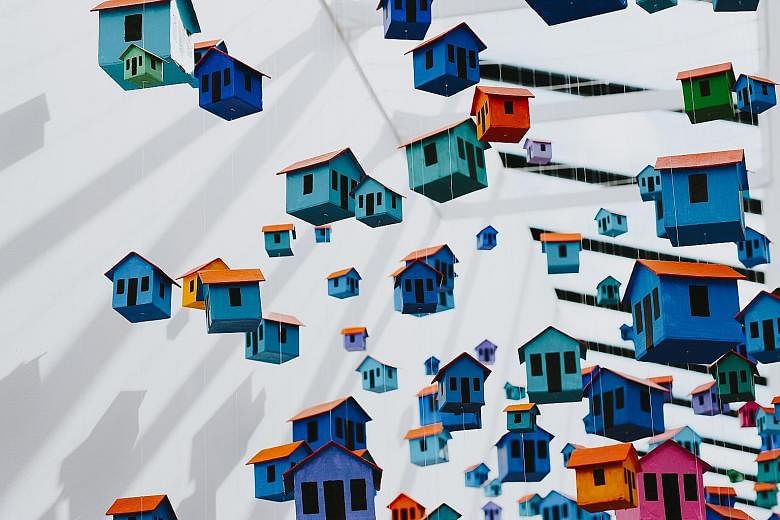NEW YORK • How can a museum ensure that it serves families who may not be able to afford school lunches or new winter coats, much less crosstown trips to an arts institution?
Broadway Housing Communities, a Manhattan non-profit organisation, met this challenge with a daring resolution.
Instead of creating programmes to bring underprivileged children to an art museum, it would bring an art museum to underprivileged children.
The result is the 1,580 sq m Sugar Hill Children's Museum of Art & Storytelling, which opened in 2015 at St Nicholas Avenue and 155th Street in a neighbourhood where, the museum notes, more than 70 per cent of children are born into poverty.
But Sugar Hill is not just the only New York children's museum north of the Upper West Side. It is also the only one that anchors a low-income housing development and that has an affiliated, tuition-free pre-school.
"We were interested in creating a true art museum for children - not necessarily the indoor play spaces that sometimes define children's museums," said Ms Ellen Baxter, Broadway Housing Communities' executive director and the museum's board president.
"In particular, we wanted to focus on nurturing the creative intelligence of young children."
To fund the museum, she relied heavily on the New Markets Tax Credit Programme, which awards federal income tax credits to investors putting capital into impoverished communities.
By also using housing tax credits, she said, her organisation could "form a more comprehensive oasis in a neighbourhood of need": the US$84-million (S$116-million) Sugar Hill Project, which comprises the museum, the pre-school and the residences.
Broadway Housing selected Sir David Adjaye, lead architect for the Smithsonian's National Museum of African American History & Culture, to create a single structure for the project, which is named for its neighbourhood.
His 13-storey building, with a subtle rose pattern on its corrugated concrete surface, has the museum and school at its base and 124 apartments above. From a distance, its playful elegance evokes children's blocks wrapped in grey corduroy.
Full-price admission to Sugar Hill, which is free to visitors eight years old and younger and offers a free Sunday each month, is US$7.
Ms Lauren Kelley, the museum's director and chief curator and an artist herself, said: "We're also a space that honours people of colour. Artists of colour, artists of the Harlem Renaissance, thinkers of the Harlem Renaissance."
But while the museum has welcomed more than 56,000 visitors so far, it has had growing pains.
At its start, the venerable artist it most wanted to celebrate was Faith Ringgold, a Harlem native for whom the museum was to be named. But in 2011, Ringgold, frustrated by the plans' pace and concerned that they would not include a true art museum, withdrew her name and support.
She has since come around - so much so that the museum recently opened Sugar Hill Songbook: Select Work By Faith Ringgold, a show of her quilts, soft sculpture, illustrations and works on paper.
"I think all children love art, but not all get the opportunity to do it," Ringgold said in a telephone interview. "This is a place where they can see the art, do it, be inspired by it."
But while young visitors may recognise pieces by Ringgold, who is also a children's book author, they regularly encounter Sugar Hill exhibitions that are abstract or conceptual.
An intriguing paradox is that the museum focuses on both a very young population - children three to eight years old - and very sophisticated work.
"If it didn't say 'children's museum', it could be a museum for anyone," said Ms Jennifer Ifil-Ryan, Sugar Hill's deputy director and director of creative engagement.
In fact, it has just opened two other shows that would fit in easily downtown at the New Museum: Justin Favela: Recuerdame, an enormous commissioned mural about Mexico in one of Favela's favourite materials, pinata paper; and Yuken Teruya: Cutting Trees, featuring tree dioramas made from cut and folded paper bags.
Sugar Hill makes its artwork accessible with dual wall labels, one set written in language geared towards adults and the other offering information and questions for children.
It also approaches fine art through storytelling - the museum offers an interactive story programme every day it is open - and by encouraging exploration of artists' materials in its Studio Lab, a well-stocked space for visitors.
But following the principles of Reggio Emilia, a progressive educational approach founded in Italy, it never dictates what projects to make.
"It's exciting to see how kids approach a table full of interesting and provocative materials," said Mr Anthony Gonzalez, who directs the museum's school programmes and special projects. "When we create the presentation on the table, it has to look like dessert - so when the kids are 3m away, they look at our table and go, 'Aah.'"
NYTIMES

